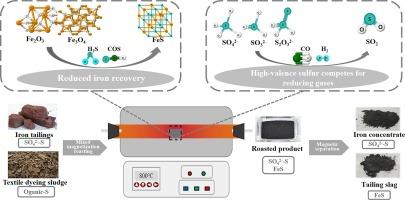Insights into sulfur migration and transformation during the magnetization roasting of iron tailings and textile dyeing sludge
IF 7.1
2区 环境科学与生态学
Q1 ENGINEERING, ENVIRONMENTAL
引用次数: 0
Abstract
Magnetization roasting of iron tailings (IT) is an effective method to recovery fine iron concentrate (IC) from refractory IT. However, the migration and transformation of sulfur during the roasting process remain unclear, impacting iron quality if sulfur content exceeds the allowable limit value. This study investigates the sulfur release and fixation during magnetization roasting of textile dyeing sludge (TDS) and IT, elucidating the sulfur migration and transformation processes. Results indicate that 31.7 % of sulfur migrates to the gas phase due to the thermal decomposition of organic-S and the reduction of high-valent sulfur to SO2 by H2 and CO. The total sulfur (TS) content in tailing slag (TSL) (1.96 %) is significantly higher than that in the roasted product (RP) (0.84 %), suggesting a tendency for sulfur migration into TSL. This migration is attributed to reactions between H2S/COS and Fe2O3/Fe3O4, resulting in the formation of non-magnetic byproduct FeS. Additionally, due to the symbiosis of hematite and sulfate, sulfur in the IC primarily exists as sulfate sulfur (76.98 %). This research is crucial for quality control in iron ore processing and provides theoretical guidance for sulfur regulation in practical production processes.

铁尾矿和纺织印染污泥磁化焙烧过程中硫迁移和转化的启示。
对铁尾矿(IT)进行磁化焙烧是一种从难选 IT 中回收精铁精矿(IC)的有效方法。然而,硫在焙烧过程中的迁移和转化仍不清楚,如果硫含量超过允许限值,就会影响铁的质量。本研究调查了纺织印染污泥(TDS)和 IT 在磁化焙烧过程中的硫释放和固定情况,阐明了硫的迁移和转化过程。结果表明,由于有机硫的热分解以及 H2 和 CO 将高价硫还原为 SO2,31.7% 的硫迁移到气相中。尾渣 (TSL) 中的总硫 (TS) 含量(1.96%)明显高于焙烧产品 (RP) 中的总硫 (0.84%),这表明硫有向 TSL 中迁移的趋势。这种迁移可归因于 H2S/COS 与 Fe2O3/Fe3O4 之间的反应,从而形成非磁性副产品 FeS。此外,由于赤铁矿和硫酸盐的共生作用,集成电路中的硫主要以硫酸盐硫(76.98%)的形式存在。这项研究对铁矿石加工的质量控制至关重要,并为实际生产过程中的硫调节提供了理论指导。
本文章由计算机程序翻译,如有差异,请以英文原文为准。
求助全文
约1分钟内获得全文
求助全文
来源期刊

Waste management
环境科学-工程:环境
CiteScore
15.60
自引率
6.20%
发文量
492
审稿时长
39 days
期刊介绍:
Waste Management is devoted to the presentation and discussion of information on solid wastes,it covers the entire lifecycle of solid. wastes.
Scope:
Addresses solid wastes in both industrialized and economically developing countries
Covers various types of solid wastes, including:
Municipal (e.g., residential, institutional, commercial, light industrial)
Agricultural
Special (e.g., C and D, healthcare, household hazardous wastes, sewage sludge)
 求助内容:
求助内容: 应助结果提醒方式:
应助结果提醒方式:


